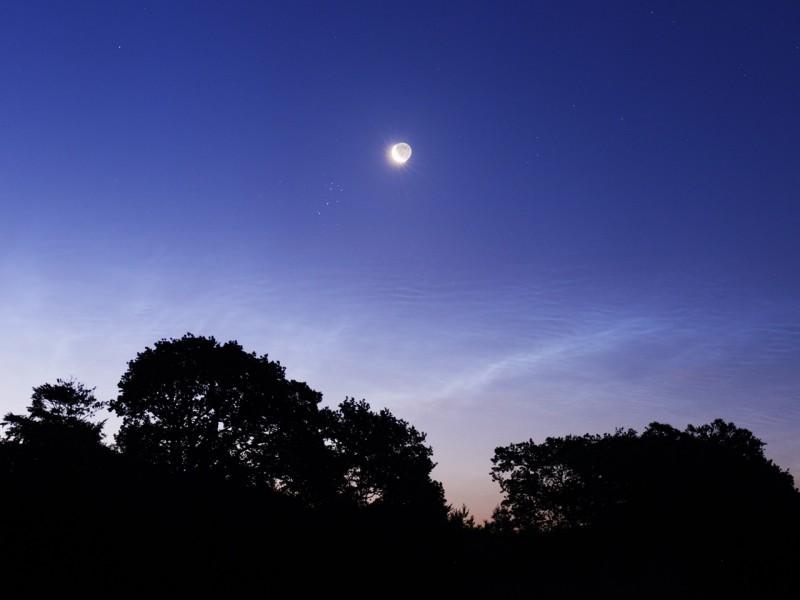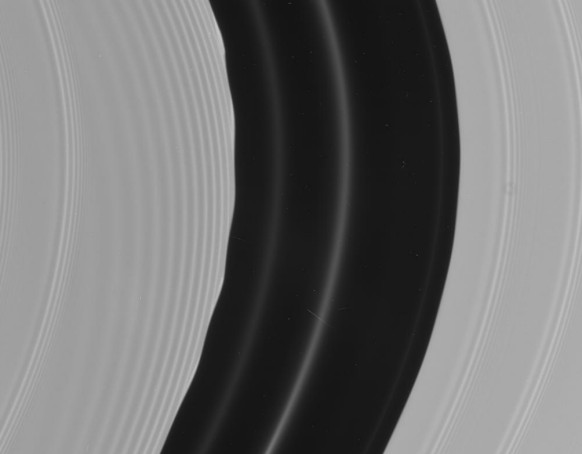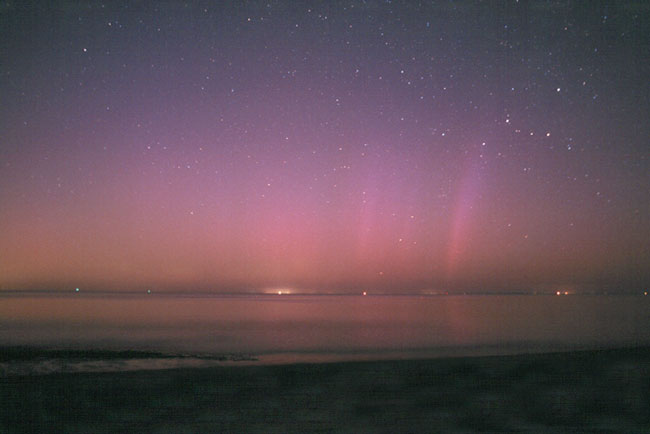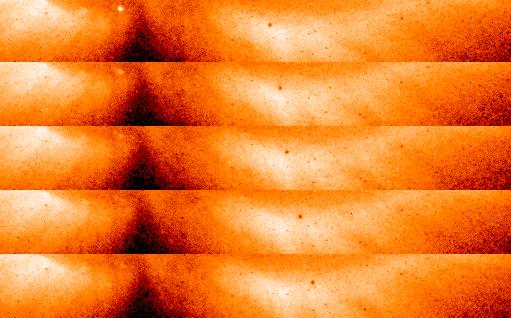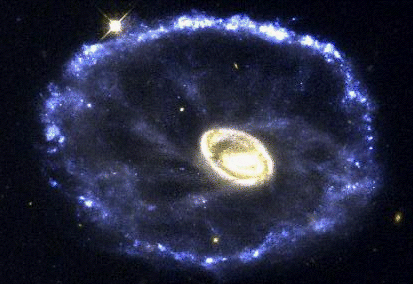| << Previous | Index | Next >> |
2015 On June 30, Venus and Jupiter were close in western skies at dusk. Near the culmination of this year's gorgeous conjunction, the two bright evening planets are captured in the same telescopic field of view in this image taken after sunset from Bejing, China. As the two bright planets set together in the west, a nearly Full Moon rose above the horizon to the south and east. Imaged that night with the same telescope and camera, the rising Moon from the opposite part of the sky is compared with the planetary conjunction for scale in the digitally composited image. The full lunar disk covers an angle of about 1/2 degree on the sky. Visible as well in binoculars and small telescopes are Venus' crescent and Jupiter's four Galilean moons. Of course, Venus and Jupiter are still close.
2014
2013
Click to play embedded YouTube video.
Image Credit & Copyright: Robert Nemiroff (MTU)
2012
Click to play embedded YouTube video.
Video Credit: ESO/MPE/Nick Risinger (skysurvey.org)/VISTA/J. Emerson/Digitized Sky Survey 2
2011 Brilliant Venus and a thin crescent Moon stood together above the eastern horizon just before sunrise on June 30. The lovely celestial pairing is captured in this colorful twilight skyview overlooking a reservoir near Izmir, Turkey. For some, the close conjunction could be viewed as a daylight occultation. While Venus is nearing the end of its latest performance as planet Earth's morning star, the old lunar cresent, about 24 hours from its New Moon phase, was also bidding farewell for now to the dawn. In fact, for the next two nights a young Moon can be spotted just after sunset. Look for a thin sunlit sliver close to the western horizon, not far from bright planet Mercury.
2010 Galaxies NGC 5216 (top) and NGC 5218 really do look like they are connected by a string. Of course, that string is a cosmic trail of gas, dust, and stars about 22,000 light-years long. Also known as Keenan's system (for its discoverer) and Arp 104, the interacting galaxy pair is some 17 million light-years away in the constellation Ursa Major. The debris trail that joins them, along with NGC 5218's comma-shaped extension and the distorted arms of NGC 5216, are a consequence of mutual gravitational tides. The tides disrupt the galaxies as they repeatedly swing close to one another. Drawn out over billions of years, the encounters will likely result in their merger into a single galaxy of stars. Such spectacular galactic mergers are now understood to be a normal part of the evolution of galaxies, including our own Milky Way.
2009
2008 In the early morning hours of June 30th, ghostly clouds hovered in the east in this view of near dawn skies over western France. The noctilucent or night-shining clouds lie near the edge of space, reflecting sunlight from about 80 kilometers above Earth's surface. Usually spotted above the poles in summer, they are now seen with increasing frequency farther from the poles, in this case extending to the photographer's latitude of about 48 degrees north. The trend could be a telltale sign of global changes in the atmosphere. Another 400,000 kilometers away, the Moon's sunlit crescent shines brightly, its night side illuminated by Earthshine. Of course, as a bonus for early risers June's old crescent Moon was followed closely across the sky by the lovely Pleiades star cluster, surrounded by cosmic dust clouds and shining from a mere 400 light-years away.
2007
Click to play embedded YouTube video.
Credit & Copyright: Filipe Alves
2006 The scene might have been considered serene if it weren't for the tornado. Last June in Kansas, storm chaser Eric Nguyen photographed this budding twister in a different light -- the light of a rainbow. Pictured above, a white tornado cloud descends from a dark storm cloud. The Sun, peeking through a clear patch of sky to the left, illuminates some buildings in the foreground. Sunlight reflects off raindrops to form a rainbow. By coincidence, the tornado appears to end right over the rainbow. Streaks in the image are hail being swept about by the high swirling winds. Over 1,000 tornadoes, the most violent type of storm known, occur on Earth every year, many in tornado alley. If you see a tornado while driving, do not try to outrun it -- park your car safely, go to a storm cellar, or crouch under steps in a basement.
2005 On Tuesday, June 28th, the setting Sun flooded the horizon with a beautiful warm light in this view from the beach beside the pier at Brighton in Adelaide, South Australia. The Sun also illuminated three planets gathered in the western sky, Mercury, Venus, and Saturn. From this perspective Mercury is at the highest point in the celestial triangle, brilliant Venus is just below, and Saturn stands farther to the left and below the close pair. Of course, the planets only appear close together on the sky but are actually quite far apart in space. The orbits of Mercury and Venus are both interior to Earth's orbit, while gas giant Saturn lies in the outer solar system, over nine astronomical units from the Sun. Late next week, Venus and Mercury will share western skies with the young crescent Moon.
2004 Yesterday, Cassini became the first spacecraft to enter orbit around gas giant Saturn, rocketing through a 25,000 kilometer wide gap in the distant planet's magnificent system of icy rings at about 15 kilometers per second. Turning to snap pictures, Cassini's narrow angle camera recorded this stunning close-up of a much smaller gap in the rings, the Encke Gap. A mere 300 kilometers wide, the Encke Gap is flanked by amazing structures within the rings -- scalloped edges and patterns of density waves are clear in the sharp image. While the rings of Saturn are likely debris from the breakup of a fair-sized icy moon, the Encke Gap itself is created by the repeated passage of a tiny moon. Only 20 kilometers wide that tiny moon, Pan, was also detected by Cassini's camera as the spacecraft approached the Saturnian system.
2003 Active pillars of colorful aurora were captured dancing over a serenely smooth and nearly colorless Cape Cod Bay last month. North is straight ahead so that the town lights near the center originate from Provincetown, Massachusetts, USA. The unusual red colors in the aurora slightly reflect off the ocean inlet. Several familiar constellations are visible in the sky, including the famous stellar W of Cassiopeia on the far right.
2002 What color is the universe? More precisely, if the entire sky was smeared out, what color would the final mix be? This whimsical question came up when trying to determine what stars are commonplace in nearby galaxies. The answer, depicted above, is a conditionally perceived shade of beige. To determine this, astronomers computationally averaged the light emitted by one of the largest sample of galaxies yet analyzed: the 200,000 galaxies of the 2dF survey. The resulting cosmic spectrum has some emission in all parts of the electromagnetic spectrum, but a single perceived composite color. This color has become much less blue over the past 10 billion years, indicating that redder stars are becoming more prevalent. In a contest to better name the color, notable entries included skyvory, univeige, and the winner: cosmic latte.
2001 Soon it will be winter in Saturn's northern hemisphere. Since Saturn is tilted in its orbit around the Sun, it has seasons just like the Earth. When a hemisphere is tilted so that the Sun passes more directly overhead, summer occurs. Half an orbit later -- about 15 (Earth) years for Saturn -- winter occurs. Since the rings of Saturn orbit the equator, they provide a quite graphic seasonal display. The Hubble Space Telescope took the above sequence of images about a year apart, starting on the lower left in 1996. Saturn's rings are less than 50 meters thick and are composed of pebble and boulder sized chunks of dusty water ice.
2000 Gamma-Ray Bursts (GRBs) were discovered by accident. Thirty three years ago today, satellites first recorded a GRB. The data plotted here show that the count rate of the satellite gamma-ray instrument abruptly jumped indicating a sudden flash of gamma-rays. The Vela satellites that detected this and other GRBs were developed to test technology to monitor nuclear test ban treaties. With on board sensors they watched for brief x-ray and gamma-ray flashes, the telltale signatures of nuclear explosions. As intended, the Velas found flashes of gamma-rays - but not from nuclear detonations near Earth. Instead, the flashes were determined to come from deep space! Dubbed "cosmic gamma-ray bursts" they are now known to be the most powerful explosions originating in distant galaxies. What could power a gamma-ray burst?
1999 Hale-Bopp, the Great Comet of 1997, may have been the most viewed comet in history - visible even from bright metropolitan skies. Astronomers are now reporting that this magnificent comet also cast a shadow against the glare of the solar system's ultraviolet haze. This false-color image represents a slice of the sky viewed by the SWAN (Solar Wind ANisotropy) instrument aboard the space-based SOHO observatory. Recorded on March 8, 1997 it shows a general haze of solar ultraviolet light scattered by interstellar hydrogen. The sun itself is positioned below the bottom center of the cropped image and the large bright spot is ultraviolet sunlight scattered by the cloud of hydrogen gas surrounding Hale-Bopp's nucleus. Just above and to the left is a broad, diffuse, dark streak - the 150 million kilometer long shadow produced by the denser regions of this hydrogen envelope. Why are comets surrounded by hydrogen? The hydrogen comes from the breakup of water (H20) vapor released as the comet nucleus approaches the sun. These observations indicate that Hale-Bopp's nucleus was producing about 300 tons of water per second.
1998 This sequence of false color X-ray images captures a rare event - the passage or transit of planet Mercury in front of the Sun. Mercury's small disk is silhouetted against the bright background of X-rays from the hot Solar Corona. It appears just to the right of center in the top frame and moves farther right as the sequence progresses toward the bottom. The dark notch is a coronal hole near the Solar South Pole, while a flaring coronal bright point can be seen to the left of the notch in the top frames. The frames were recorded on November 6, 1993 by the Soft X-ray Telescope on board the orbiting Yohkoh satellite. Transits of Mercury (and Venus) were historically used to discover the geometry of the solar system and to map planet Earth itself.
1997 Gamma-Ray Bursts (GRBs) were discovered by accident. In fact, GRBs always seem to be where scientists least expect them. Thirty years ago today, satellites first recorded a GRB. The burst data plotted in this histogram show that the count rate of the gamma-ray instrument abruptly jumped indicating a sudden flash of gamma-rays. The Vela satellites that detected this and other GRBs were developed to test technology to monitor nuclear test ban treaties. With on board sensors they watched for brief X-ray and gamma-ray flashes, the telltale signs of nuclear explosions from the vicinity of the Earth. As intended, the Velas found flashes of gamma-rays - but not from nuclear detonations near Earth. Instead, the flashes came from deep space! Dubbed "cosmic gamma-ray bursts" their origin was then unknown and is still controversial. However, the gamma-ray surprises were not over. Exploring the high-energy sky nearly 25 years later, the orbiting Compton Observatory's Burst and Transient Source Experiment (BATSE), intentionally designed to detect cosmic gamma-ray bursts, was searching for clues to the GRB mystery. But the second burst BATSE recorded did not come from deep space. It came from near the Earth! Don't worry, these terrestrial GRBs are not nuclear bombs exploding. They are a new phenomenon now thought to be related to a recently discovered type of high altitude lightning. Exploring new horizons continues to yield unexpected results.
1996 What will NASA rockets look like in the future? Today's announcement gave one indication. Today Vice- President Al Gore announced that the Lockheed Martin Corporation will work with NASA to produce a reusable rocket with a remote pilot. Currently designated the X-33 program, the flight demonstration rocket design will utilize only a single stage, cost relatively little per launch, and be ready for re-launch within days. It is expected that an X-33 type rocket will be in use by NASA by the the year 2000. Pictured above is an artistic depiction of the candidate vehicle.
1995 The Cartwheel Galaxy shows a ring that is the result of a collision between a small and a large galaxy. After a small galaxy has moved through a big galaxy - in this case one that probably resembled our own Milky Way - a star formation wave moves out from the impact point like ripples across the surface of a pond. When galaxies collide it is rare that any two stars actually collide. Gravity, however, causes density waves to move out through the galaxy which in turn triggers the formation of hot, bright young stars, producing the ring that we see in this picture.
| << Previous | Index | Next >> |





